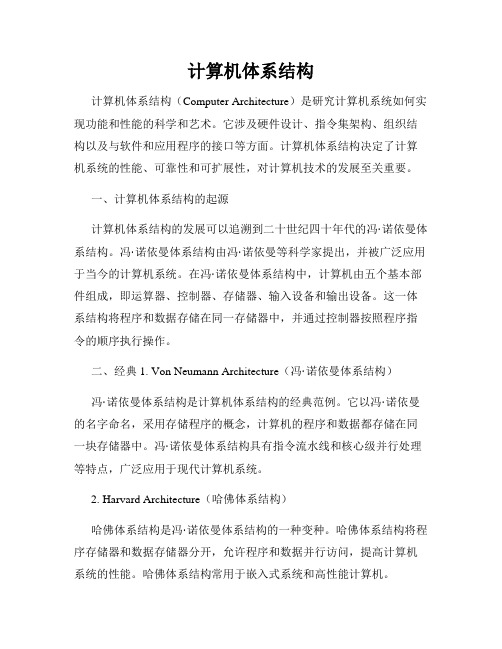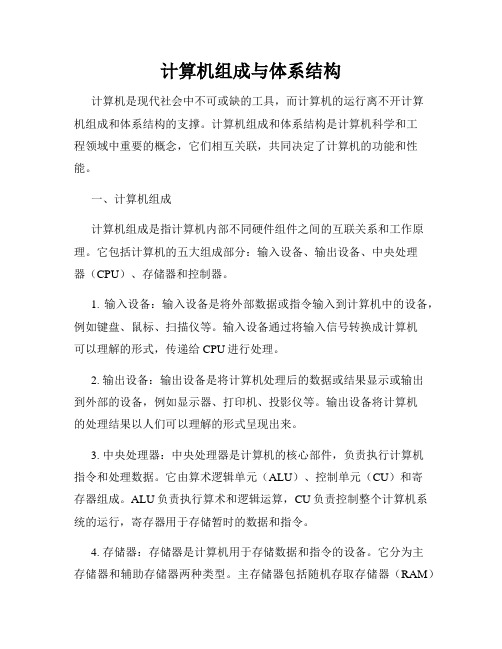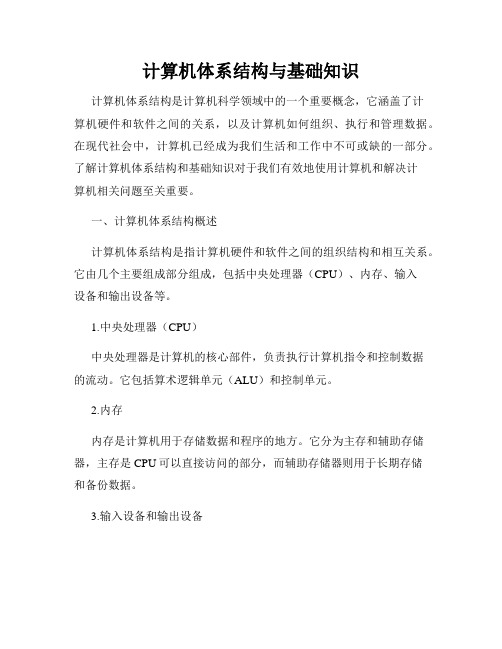计算机组成与体系结构Ch4_ECOA (2)
计算机组成与体系结构

计算机组成与体系结构计算机组成与体系结构是计算机科学中的重要理论基础之一。
它涉及到计算机硬件架构、逻辑设计和计算机内部各组件之间的相互关系。
本文将从计算机的组成和体系结构的概念入手,深入讨论计算机内部各组件的功能和相互连接的方式,同时介绍计算机的工作原理和性能优化。
一、概念解析在介绍计算机组成与体系结构之前,首先需要澄清它们的定义。
计算机的组成是指计算机硬件部件的构成和相互连接方式,包括中央处理器(CPU)、存储器、输入输出设备等。
而计算机的体系结构则是指计算机的功能与数据的表示方式,包括指令集体系结构(Instruction Set Architecture,ISA)和处理器微体系结构(Microarchitecture)。
二、计算机组成1. 中央处理器(CPU)中央处理器是计算机的核心,负责执行指令和进行运算。
它由运算器和控制器组成,其中运算器用于执行各类算术和逻辑运算,而控制器则负责解析和执行指令。
CPU中的寄存器用于存储指令和数据。
2. 存储器存储器用于存储指令和数据,是计算机的内部存储设备。
常见的存储器包括内存(主存)和硬盘(辅助存储器)。
内存用于暂时存储正在执行的程序和数据,而硬盘则用于永久存储程序和数据。
3. 输入输出设备输入输出设备用于计算机与外部世界的信息交换。
常见的输入设备有键盘、鼠标和扫描仪,而输出设备包括显示器、打印机和音频设备。
输入输出设备通过接口与计算机主机相连接。
三、计算机体系结构1. 指令集体系结构(ISA)指令集体系结构定义了处理器与软件之间的接口,包括指令的类型、寻址方式和编码方式。
常见的ISA有x86、ARM和MIPS等。
ISA的选择和设计对计算机的性能和运行效率有很大影响。
2. 处理器微体系结构(Microarchitecture)处理器微体系结构是指处理器内部的设计和实现方式,包括流水线、超标量、乱序执行等技术。
微体系结构的优化可以提高处理器的性能和执行效率,比如增加缓存、优化指令调度算法等。
计算机二级考试攻略 解读计算机组成原理与体系结构

计算机二级考试攻略解读计算机组成原理与体系结构计算机二级考试攻略解读计算机组成原理与体系结构计算机二级考试是一个重要的考试,涵盖了计算机的各个方面知识。
其中,计算机组成原理与体系结构是一项重要的考试内容。
本文将解读计算机组成原理与体系结构,并提供一些攻略,帮助考生在考试中取得好成绩。
一、计算机组成原理与体系结构概述计算机组成原理与体系结构是计算机科学与技术的基础课程之一。
它主要研究计算机硬件系统的组成、功能和结构。
计算机组成原理强调计算机硬件层面上的逻辑设计和实现,而体系结构则主要关注计算机硬件与软件之间的接口关系。
计算机组成原理主要涵盖以下内容:计算机的基本组成,包括中央处理器(CPU)、存储器、输入输出设备等;计算机的数据表示和运算方法,包括二进制、十进制、十六进制等表示方法,以及各种运算指令;计算机的控制方式,包括单指令周期、多指令周期等控制方式。
计算机体系结构则主要涵盖以下内容:计算机指令系统的设计,包括指令的分类、格式和编码;计算机的存储器层次结构,包括主存、高速缓存以及辅助存储器等;计算机的总线结构,包括地址总线、数据总线和控制总线等;计算机的输入输出系统,包括输入输出设备和接口等。
二、攻略一:深入理解计算机组成原理与体系结构的基本概念在备考计算机二级考试时,首先要深入理解计算机组成原理与体系结构的基本概念。
这包括理解计算机的基本组成部分,如中央处理器、存储器和输入输出设备等;理解计算机的基本工作原理,如指令的执行流程、数据的传输方式等;理解计算机系统的层次结构,如指令系统、存储器层次结构和总线结构等。
三、攻略二:熟悉计算机组成原理与体系结构的常见考点在备考计算机二级考试时,还需要熟悉计算机组成原理与体系结构的常见考点。
这些考点包括计算机指令系统的设计原则和分类、计算机存储器层次结构的组成和工作原理、计算机总线结构的组成和传输方式、计算机输入输出系统的功能和接口等。
通过对这些考点的理解和掌握,可以更好地应对考试中的相关问题。
大学计算机基础——第一讲ch4计算机结构

二进制(binary) 0,1 (逢二进一)
m
N= bi×2i
八进制(octal)
in
0,1,...,7
(逢八进一)
N= oi×8mi
十进制(decimal) i0n,1,...,9 (逢十进一)
N= di×1m0i
十六进制(shíliùjiìnn zhì)(hex) 0,1,...,9,A,B,C,D,E,F (逢十六进一)
优点:元件状态少,处理简单、可靠。
③逻辑性强
二进制数字0和1正好代表逻辑代数中的‘假’ 和‘真’。因此,可用逻辑代数作为工具分析 和设计计算机中的逻辑电路,使逻辑电路成为 计算机设计的数学基础。
精品资料
3)信息存储单位 位(bit比特,缩写b):
二进制的每一位(0或1)是二进制信息的最小 单位,存储器中最小存储单位称为一个存储位 (bit)。 字节(byte ,缩写B):
N = hi×1m6i
in
精品资料
2)计算机采用二进制的原因
①二进制数运算简单 只有0和1两个数。“逢二进一”; 二进制数是由一串0和1的数构成。
二进制数加法运算规则(guīzé): 0+0=0; 0+1=1+0=1; 1+1=10 (逢二进一) 例: 计算1011011+1010.11
1011011 + 1 0 1 0.1 1
精品资料
程序执行过程(guòchéng)
取指令
分析指令
结束指令?
N
执行指令
由不同(bù tón 功能部件 完成
Y
结束
精品资料
流水线工作方式(fāngshì)的指令执 行过程
取指令1 取指令2 取指令3 取指令4
计算机组成与系统结构

计算机组成与系统结构计算机组成与系统结构是计算机科学中的重要领域,涉及计算机硬件和软件的设计、实现和优化。
本文将探讨计算机组成与系统结构的基本概念、原理和应用。
一、概述计算机组成与系统结构是指将计算机硬件和软件组织在一起以实现特定功能的过程。
它关注计算机系统中各个部分的功能、结构和相互关系。
计算机组成与系统结构的目标是实现高性能、高可靠性和可扩展性的计算机系统。
二、计算机组成1. 中央处理器(Central Processing Unit,简称CPU)中央处理器是计算机的核心部件,负责执行指令和处理数据。
它由控制器和运算器组成。
控制器负责解析和执行指令,而运算器负责执行算术和逻辑操作。
2. 存储器存储器用于存储程序和数据。
常见的存储器包括内存(Random Access Memory,简称RAM)和磁盘存储器。
内存是计算机中主要的工作存储器,用于临时存储程序和数据。
磁盘存储器则用于长期存储大量数据。
3. 输入输出设备输入输出设备用于与计算机进行交互。
常见的输入设备包括键盘、鼠标和触摸屏,而输出设备包括显示器和打印机。
输入输出设备通过与计算机的接口进行数据传输。
三、系统结构1. 单处理器系统单处理器系统是指只有一个中央处理器的计算机系统。
它具有简单的结构和较低的成本,但处理能力有限。
在单处理器系统中,任务按照顺序执行,无法并行处理多个任务。
2. 多处理器系统多处理器系统是指具有多个中央处理器的计算机系统。
多处理器系统能够并行处理多个任务,提高计算能力和系统吞吐量。
多处理器系统可以进一步划分为对称多处理系统和非对称多处理系统。
3. 分布式系统分布式系统是指由多个计算机连接而成的系统。
在分布式系统中,计算机之间通过网络进行通信和协同工作。
分布式系统具有高可靠性和可扩展性,能够处理大规模的计算和存储任务。
四、应用领域计算机组成与系统结构的理论和技术在各个领域得到广泛应用。
例如,在超级计算机中,通过结合多个处理器和存储器单元,可以实现高性能的科学计算;在嵌入式系统中,通过优化计算机硬件和软件的结构,可以实现低功耗和高效率的计算。
认识计算机的基本构成和组织结构

认识计算机的基本构成和组织结构计算机是我们日常生活中不可或缺的一个工具,无论是工作、学习还是娱乐,计算机都为我们提供了非常便捷和高效的方式。
但是,对于计算机的构成和组织结构,很多人都存在着模糊和不清楚的情况。
因此,本文将详细介绍计算机的基本构成和组织结构。
一、计算机的基本构成1. 输入设备:输入设备是计算机与外部世界交互的桥梁,其中最重要的输入设备就是键盘和鼠标。
此外,还有触摸屏、扫描仪、摄像头等输入设备。
2. 输出设备:计算机通过输出设备将其结果显示给用户,例如,显示器或打印机等。
3. 中央处理器:中央处理器是计算机最重要的组成部分,它是计算机的大脑。
其主要作用是接收和执行指令。
中央处理器通常分为两部分:控制器和算术逻辑单元(ALU),其中控制器负责解释执行指令,而ALU对数据进行加减乘除等运算。
4. 存储器:存储器用于存储程序和数据。
它通常分为两种类型:随机存储器(RAM)和只读存储器(ROM)。
RAM是一种易失性存储器,它允许计算机随时存放和取出数据,而ROM则是一种只读存储器,其中保存了程序和数据的固定信息,而不允许在运行时修改。
5. 外部存储设备:除了内存存储器外,我们还可以使用外部存储设备来存储大量的数据,例如硬盘驱动器、U盘和CD/DVD。
6. 硬件接口:硬件接口连接每个组成部分,例如USB、HDMI等接口。
它们允许我们将其他设备和计算机连接起来,以便进行数据传输和其他操作。
7. 操作系统:操作系统是一种非常基本的软件,它负责管理和协调计算机硬件资源,同时为用户提供界面和其他服务。
例如,Windows、macOS和Linux都是常见的操作系统。
8. 应用程序:应用程序是计算机上安装的其他软件,例如Microsoft Word和Adobe Photoshop。
这些应用程序允许我们进行更具体的工作。
9. 内部组件:计算机还由一些内部组件组成,例如风扇、电源和主板等。
二、计算机的组织结构在了解计算机的基本构成之后,我们来了解一下计算机的组织结构。
计算机体系结构和计算机组成原理

计算机体系结构和计算机组成原理
计算机体系结构和计算机组成原理是计算机科学中非常重要的两个概念。
计算机体系结构是指计算机硬件和软件之间的接口,它定义了计算机的组成部分以及它们之间的关系。
计算机组成原理则是指计算机硬件的实现方式,包括处理器、存储器、输入输出设备等。
计算机体系结构和计算机组成原理是密不可分的。
计算机体系结构的设计必须考虑到计算机组成原理的实现方式,而计算机组成原理的实现方式也必须符合计算机体系结构的要求。
例如,计算机体系结构中的指令集架构(ISA)定义了计算机的指令集和寄存器,而计算机组成原理则负责实现这些指令和寄存器。
计算机体系结构和计算机组成原理的发展历程可以追溯到计算机诞生的早期。
早期的计算机采用的是电子管和继电器等元器件,这些元器件的体积庞大、功耗高、寿命短,限制了计算机的发展。
随着半导体技术的发展,计算机的体积逐渐缩小,功耗降低,性能提高。
现代计算机采用的是微处理器、内存芯片、硬盘等集成电路,这些元器件的体积小、功耗低、寿命长,使得计算机的性能得到了极大的提升。
计算机体系结构和计算机组成原理的发展也推动了计算机应用的发展。
计算机的应用范围从最初的科学计算扩展到了商业、娱乐、通信等领域。
计算机的应用也从单机应用扩展到了分布式应用、云计算等新兴领域。
计算机体系结构和计算机组成原理是计算机科学中非常重要的两个概念。
它们的发展推动了计算机技术的进步,也推动了计算机应用的发展。
未来,随着人工智能、物联网等新兴技术的发展,计算机体系结构和计算机组成原理的研究将会更加深入,为人类带来更多的便利和创新。
计算机组成与体系结构总结

计算机组成与体系结构第一章总结1、 电子计算机的分类:电子模拟计算机和电子数字计算机特点:模拟计算机是数值由连续量来表示,运算过程连续; 数字计算机是按位运算,并且不连续地跳动计算; 2、 电子(数字)计算机分类专用计算机和通用计算机(依据效率,速度,价格,运行的经济性和适应性划分) 3、 计算机系统由硬件和软件两大部分组成 4、 硬件(1)一般的计算机结构框图(运算器为中心)一般的计算机结构框图(存储器为中心)(2)冯.诺依曼计算机的特点采用二进制表示机器指令和数据硬件系统由运算器、控制器、存储器、输入设备和输出设备五大部分组成程序和数据预先存放在存储器中,存储器按地址编址操作时根据程序中指令的执行顺序,从存储器中取出指令或数据,由控制器解释,运算器完成运算设计思想:采用二进制表示各种信息以及存储程序和程序控制。
存储程序的概念是将解题程序(连同必须的原始数据)预先存入存储器;程序控制是指控制器依据所存储的程序控制全机自动、协调地完成解题任务。
存储程序并按地址顺序执行。
存储程序和程序控制统称为存储程序控制。
(3)硬件各个主要部分 ①运算器:(如右图)算术运算和逻辑运算在计算机中参与运算的数是二进制的运算器的长度一般是8、16、32或64位 ②存储器: 存储数据和程序容量 ——存储器所有存储单元的总数(存储单元(保存一个数16个触发器)、存储单元地址(每个存储单元的编号)、容量单位)内存储器(ROM 、RAM ):半导体存储器外存储器:计算机中配备了存储容量更大的磁盘存储器和光盘存储器 存储器单位:210 byte =1K 210 K =1M 210 M =1G 210 G =1T ③控制器: 指令和程序(每一个基本操作叫做一条指令;解决某一问题的一串指令序列叫做程序) 指令的形式——操作码和地址码:指令的内容由两部分组成,操作的性质和操作数的地址;前者称为操作码,后者称为地址码。
控制器的基本任务:按照一定的顺序一条接着一条取指令、指令译码、执行指令。
计算机组成与体系结构

计算机组成与体系结构计算机作为现代社会不可或缺的工具,已经深入到我们生活的方方面面。
我们使用电脑上网、购物、学习、娱乐,但是我们是否了解计算机背后的组成和体系结构呢?本篇文章将为大家介绍计算机组成与体系结构。
一、计算机组成计算机的组成由许多不同而又密切相连的部分组成,每个部分都有不同的功能。
首先,计算机的核心部分是中央处理器(CPU),它负责执行计算和控制计算机的运行。
在CPU中,最重要的是微处理器,它由数以亿计的晶体管组成,可以执行指令和处理数据。
另外一个重要的组成部分是内存(RAM),cpu对于存储在内存中的数据进行读取和写入。
内存是计算机的临时存储器,可以快速读取和存储数据。
此外,硬盘和固态硬盘也是计算机存储的一部分,它们用来长期保存数据和文件,因为它们可以在断电的情况下保持数据的完整性。
与存储器有关的还有数据总线和地址总线,它们用来传输数据和地址信息。
数据总线是用来传输数据的,地址总线是用来指示存储器的地址。
它们是计算机内部不同部件之间进行通信的重要通道。
最后,输入和输出设备也是计算机的关键组成部分。
输入设备包括键盘、鼠标、摄像头等,用于向计算机输入数据。
输出设备包括显示屏、打印机和扬声器等,用于将计算机处理的数据显示或输出。
二、计算机体系结构计算机体系结构是指计算机硬件和软件之间的接口,它决定了计算机如何工作和组织。
常见的计算机体系结构包括冯·诺依曼体系结构和哈佛体系结构。
冯·诺依曼体系结构是最早也是最流行的计算机体系结构。
它的特点是将数据和指令存储在同一个内存中,通过加载不同的地址来区分。
这种体系结构简单易懂,但是存在着内存瓶颈和指令和数据取得效率较低的问题。
哈佛体系结构是一种改进的体系结构。
与冯·诺依曼体系结构不同的是,哈佛体系结构分别存储指令和数据,通过不同的总线进行传输。
这样可以提高指令和数据的并行处理效率,但是会增加硬件的复杂度和成本。
另外,还有一些特殊的体系结构,例如向量处理器、超标量处理器和多核处理器等。
计算机组成与体系结构

计算机组成与体系结构计算机是现代科技的杰作,它的功能与性能取决于其组成和体系结构。
计算机组成与体系结构是计算机科学中一个重要的领域,它涉及到计算机硬件的构成和相互间的关系。
一、计算机组成计算机组成包括硬件和软件两个方面。
硬件是指计算机的实体部分,包括中央处理器(CPU)、存储器、输入输出设备等。
软件是指计算机程序的集合,用来指导计算机进行各种操作。
计算机组成的关键是各个部件之间的互联方式,包括总线、控制器和寄存器等。
1. 中央处理器(CPU)中央处理器是计算机的核心部分,负责执行计算机指令和处理数据。
它由运算器、控制器和寄存器组成。
运算器负责执行算术和逻辑运算,控制器负责协调和控制整个计算机系统的工作,寄存器用于存储 CPU的指令和数据。
2. 存储器存储器是计算机中用于存储数据和程序的设备。
根据存储介质的不同,可以分为内存和外存。
内存是计算机中的主要存储设备,用于存储正在执行的程序和数据。
而外存是指磁盘、光盘等较慢但容量较大的存储设备,用于长期存储数据。
3. 输入输出设备输入输出设备用于与计算机进行交互,将外部的数据和信息输入到计算机中,或将计算机处理的结果输出给外部。
常见的输入设备有键盘、鼠标和扫描仪等,输出设备有显示器、打印机和音响设备等。
二、计算机体系结构计算机体系结构是指计算机硬件和软件的组织结构,用于抽象和描述计算机的功能和性能。
不同的体系结构可以根据其指令集、内存结构和总线结构等特点进行分类。
1. 单指令流单数据流(SISD)SISD 是最简单的计算机体系结构,它包含一个处理器和一个存储器,并且每次只能处理一个数据。
这种体系结构适用于早期的计算机系统,如冯·诺依曼结构的计算机。
2. 单指令流多数据流(SIMD)SIMD 是指单指令对多个数据执行操作的体系结构。
在 SIMD 结构中,多个处理器同时执行相同的指令,但每个处理器处理的是不同的数据。
这种体系结构适用于并行计算和向量运算等领域。
计算机体系结构

计算机体系结构计算机体系结构(Computer Architecture)是研究计算机系统如何实现功能和性能的科学和艺术。
它涉及硬件设计、指令集架构、组织结构以及与软件和应用程序的接口等方面。
计算机体系结构决定了计算机系统的性能、可靠性和可扩展性,对计算机技术的发展至关重要。
一、计算机体系结构的起源计算机体系结构的发展可以追溯到二十世纪四十年代的冯·诺依曼体系结构。
冯·诺依曼体系结构由冯·诺依曼等科学家提出,并被广泛应用于当今的计算机系统。
在冯·诺依曼体系结构中,计算机由五个基本部件组成,即运算器、控制器、存储器、输入设备和输出设备。
这一体系结构将程序和数据存储在同一存储器中,并通过控制器按照程序指令的顺序执行操作。
二、经典1. Von Neumann Architecture(冯·诺依曼体系结构)冯·诺依曼体系结构是计算机体系结构的经典范例。
它以冯·诺依曼的名字命名,采用存储程序的概念,计算机的程序和数据都存储在同一块存储器中。
冯·诺依曼体系结构具有指令流水线和核心级并行处理等特点,广泛应用于现代计算机系统。
2. Harvard Architecture(哈佛体系结构)哈佛体系结构是冯·诺依曼体系结构的一种变种。
哈佛体系结构将程序存储器和数据存储器分开,允许程序和数据并行访问,提高计算机系统的性能。
哈佛体系结构常用于嵌入式系统和高性能计算机。
3. RISC Architecture(精简指令集计算机)精简指令集计算机(Reduced Instruction Set Computer,RISC)是一种计算机体系结构,通过减少指令集的复杂性来提高计算机系统的性能。
RISC体系结构采用固定长度的指令、流水线处理和寄存器架构等特点,广泛应用于个人计算机和工作站等领域。
三、现代计算机体系结构的发展趋势1. 多核处理器随着计算机应用的复杂性和计算需求的增加,多核处理器成为现代计算机体系结构的主流趋势。
计算机组成与体系结构

计算机组成与体系结构计算机是现代社会中不可或缺的工具,而计算机的运行离不开计算机组成和体系结构的支撑。
计算机组成和体系结构是计算机科学和工程领域中重要的概念,它们相互关联,共同决定了计算机的功能和性能。
一、计算机组成计算机组成是指计算机内部不同硬件组件之间的互联关系和工作原理。
它包括计算机的五大组成部分:输入设备、输出设备、中央处理器(CPU)、存储器和控制器。
1. 输入设备:输入设备是将外部数据或指令输入到计算机中的设备,例如键盘、鼠标、扫描仪等。
输入设备通过将输入信号转换成计算机可以理解的形式,传递给CPU进行处理。
2. 输出设备:输出设备是将计算机处理后的数据或结果显示或输出到外部的设备,例如显示器、打印机、投影仪等。
输出设备将计算机的处理结果以人们可以理解的形式呈现出来。
3. 中央处理器:中央处理器是计算机的核心部件,负责执行计算机指令和处理数据。
它由算术逻辑单元(ALU)、控制单元(CU)和寄存器组成。
ALU负责执行算术和逻辑运算,CU负责控制整个计算机系统的运行,寄存器用于存储暂时的数据和指令。
4. 存储器:存储器是计算机用于存储数据和指令的设备。
它分为主存储器和辅助存储器两种类型。
主存储器包括随机存取存储器(RAM)和只读存储器(ROM),用于存储正在被处理的数据和指令。
辅助存储器包括硬盘、光盘等,用于永久性地保存数据和指令。
5. 控制器:控制器负责控制计算机中不同硬件组件的工作,协调计算机的运行。
它根据指令的要求,向其他硬件发出控制信号,使计算机正确地执行指令。
二、计算机体系结构计算机体系结构是指计算机硬件和软件之间的接口,以及计算机内部不同硬件组件之间的互联和工作方式。
它包括计算机的层次结构、指令集架构和数据流结构。
1. 计算机层次结构:计算机层次结构是指计算机硬件组件按照从底层到顶层的层次排列的方式。
常用的计算机层次结构包括冯·诺依曼结构和哈佛结构。
冯·诺依曼结构中,存储器共享程序和数据,指令和数据都存储在同一块存储器中。
计算机组成与体系结构简介

计算机组成与体系结构简介引言:计算机组成与体系结构是计算机科学中非常重要的概念,它们涉及到了计算机硬件和软件的组成、工作原理、层次结构等方面。
本文将对计算机组成与体系结构进行简要介绍,并分为以下几个部分进行阐述。
一、计算机组成的基本概念:1.计算机硬件组成:包括中央处理器(CPU)、内存、输入输出设备等。
2.计算机硬件工作原理:CPU是计算机的大脑,负责执行各种指令和处理数据;内存用来存储正在使用的指令和数据;输入输出设备用于与计算机进行交互。
3.计算机中的数据表示:二进制是计算机中最基本的数据表示形式,用0和1表示逻辑上的开关状态。
二、计算机的层次结构:1.计算机的层次结构概述:为了将计算机系统的复杂性进行层次化管理,人们提出了计算机的层次结构概念。
常见的计算机层次结构包括:硬件层、微程序层、指令层、操作系统层、应用层等。
2.计算机的层次结构之间的关系:各个层次之间通过接口进行通信和交互,上层的功能依赖于下层的支持。
三、计算机体系结构的分类:1.冯·诺伊曼体系结构:由冯·诺伊曼在上世纪40年代提出,是目前计算机体系结构的主流。
其特点包括:存储程序、存储数据、按顺序执行程序、以及采用二进制表示方法等。
2.哈佛体系结构:与冯·诺伊曼体系结构相比,哈佛体系结构在存储程序和存储数据方面进行了分离,具有更高的执行效率和并行性。
3.其他体系结构:还有一些其他的计算机体系结构,如向量处理器、多核处理器等,它们在特定的应用领域中具有重要的作用。
四、计算机组成与体系结构的发展趋势:1.性能提升:随着科技的进步,计算机的性能不断提升,从CPU的时钟频率增加到多核处理器的出现,以及量子计算的研究等。
2.能源效率:计算机的能源消耗一直是个严重的问题,因此研究者们不断寻找新的方法来提高计算机的能源效率,如低功耗技术、绿色计算等。
3.可靠性和安全性:计算机的可靠性和安全性对于用户来说至关重要,因此在计算机组成与体系结构中,研究者们一直在致力于提高计算机的可靠性和安全性。
超级计算机的硬件和软件体系结构

超级计算机的硬件和软件体系结构超级计算机是一种能够执行大规模、高性能计算的计算机,它的计算速度和计算能力远超一般计算机。
对于“超级计算机”的定义一直在不断变化中,但是无论如何,它们都是目前最先进的计算机,被广泛应用于科学、工业和国防等领域。
超级计算机的核心就是它的硬件和软件体系架构,下面我将就其架构进行探讨。
一、硬件体系结构超级计算机的硬件体系结构,包括处理器、内存、存储和网络等方面。
其中,处理器是超级计算机的核心,负责执行计算任务。
与一般的计算机相比,超级计算机处理器的性能更为强大,通常采用多核心并行处理器架构。
近年来,GPU(图形处理器)也逐渐被应用于超级计算机的处理器中,通过GPU的高并行性,可以在计算高密度数据时取得更加出色的效果。
除了处理器,内存和存储也是超级计算机的重要组成部分。
内存技术的进步直接影响到超级计算机的性能,目前已经出现高带宽、大容量的内存技术,极大地提升了超级计算机的运算速度。
而存储方面,通常采用分布式存储架构,将数据存储在多个节点上,以实现数据的高可靠性、高可扩展性。
另外,超级计算机的网络也是其硬件架构的重要组成部分,因为大规模的并行处理需要大量的数据传输。
为此,超级计算机通常采用高速网络互联,以实现节点之间的数据无缝交换。
二、软件体系结构超级计算机的软件架构,包括操作系统、编程模型和应用程序等方面。
为了充分发挥超级计算机的性能,必须采用并行化的编程方法,而这需要相应的编程模型和工具支持。
目前,OpenMP、MPI和CUDA等成为常用的超级计算机编程模型,并且也在不断地发展和更新。
对于超级计算机应用程序的开发,其重要性毋庸置疑。
超级计算机通常用于科学计算、天气预测、模拟等领域,这些任务需要高精度计算和大规模的模拟运算,因此需要开发出相应的应用程序。
为此,超级计算机的软件开发也需要一定的工具链和软件库的支持,以高效地完成编译、运行和优化等工作。
三、总体架构超级计算机的总体架构,包括硬件和软件两个部分。
计算机体系结构与基础知识

计算机体系结构与基础知识计算机体系结构是计算机科学领域中的一个重要概念,它涵盖了计算机硬件和软件之间的关系,以及计算机如何组织、执行和管理数据。
在现代社会中,计算机已经成为我们生活和工作中不可或缺的一部分。
了解计算机体系结构和基础知识对于我们有效地使用计算机和解决计算机相关问题至关重要。
一、计算机体系结构概述计算机体系结构是指计算机硬件和软件之间的组织结构和相互关系。
它由几个主要组成部分组成,包括中央处理器(CPU)、内存、输入设备和输出设备等。
1.中央处理器(CPU)中央处理器是计算机的核心部件,负责执行计算机指令和控制数据的流动。
它包括算术逻辑单元(ALU)和控制单元。
2.内存内存是计算机用于存储数据和程序的地方。
它分为主存和辅助存储器,主存是CPU可以直接访问的部分,而辅助存储器则用于长期存储和备份数据。
3.输入设备和输出设备输入设备用于将外部数据输入到计算机中,例如键盘、鼠标和扫描仪等;输出设备用于将计算机处理结果呈现给用户,例如显示器、打印机和音响等。
二、计算机组成原理计算机组成原理是计算机体系结构的基础,包括计算机硬件和软件之间的相互作用以及计算机指令的执行过程等。
1.指令集架构指令集架构定义了计算机的指令集和寄存器等硬件组件。
常见的指令集架构有CISC(复杂指令集计算机)和RISC(精简指令集计算机)等。
2.数据通路和控制单元数据通路用于数据在计算机内部的传输,包括数据寄存器、数据总线和控制总线等。
控制单元则控制这些数据路径和指令执行的顺序和时序。
3.存储器结构存储器结构包括主存和辅助存储器,主存采用地址访问方式,辅助存储器则采用数据块存取方式。
存储器的组织和层次结构不同,对计算机系统的性能和功耗有重要影响。
三、计算机体系结构分类计算机体系结构可以根据硬件组成、指令集架构和并行性等因素进行分类。
1.冯·诺依曼体系结构冯·诺依曼体系结构是计算机体系结构的基础模型,它采用存储程序的方式,程序和数据存储在同一内存中。
计算机体系结构和组织

计算机体系结构和组织是计算机科学与技术的重要基础课程之一,也是计算机专业的核心课程之一。
研究的是计算机硬件的结构、功能、性能和实现原理,是计算机科学的重要分支之一。
本文将从的概念、基础知识、发展历程、现状和未来发展等方面进行论述。
一、的概念(Computer Architecture and Organization)是指计算机硬件和软件之间的关系,包括计算机硬件的结构和功能、指令系统、存储系统、输入输出系统、中央处理器、总线、操作系统等内容。
研究的是计算机系统的功能、性能和可靠性等方面,是计算机系统设计的基础。
的发展和进步,直接影响着计算机系统的性能和技术水平。
因此,掌握的理论知识和技术应用,对于计算机专业的学生来说是至关重要的。
二、的基础知识的基础知识包括计算机硬件的结构、功能和实现原理等内容。
1. 计算机硬件的结构计算机硬件的结构包括处理器、存储器、输入输出设备和总线等部分。
处理器是计算机的执行单元,主要由控制器和运算器两个部分组成,控制器负责指令的识别和调度,运算器负责算术逻辑运算和数据处理。
存储器是计算机的主要存储介质,包括内存和外存两部分。
内存是计算机的主存储器,存放正在运行和处理的数据和程序,外存是辅助存储器,用于长期保存数据和程序。
输入输出设备是计算机与外部环境交互的接口,包括键盘、鼠标、打印机、显示器等。
总线是计算机内部各部分之间的通信线路,用于传递数据和控制信号。
2. 计算机硬件的功能计算机硬件的功能主要包括数据处理、数据存储和数据传输等。
数据处理是计算机最基本的功能,包括算术逻辑运算和控制操作等。
数据存储是计算机存储和访问数据和程序的功能,包括内存和外存两部分。
数据传输是计算机内部各部分之间数据和控制信息传递的功能。
3. 计算机硬件的实现原理计算机硬件的实现原理包括数字电路、逻辑电路、微处理器等内容。
数字电路是由数字信号作为输入输出的电路,由数字电子元器件构成。
逻辑电路是数字电路的一种,是指由逻辑门器件组合而成的电路,可以实现布尔运算。
计算机专升本的计算机组成与体系结构

计算机专升本的计算机组成与体系结构计算机专升本的学习内容由计算机科学与技术相关的知识组成,其中的核心部分是计算机组成与体系结构。
计算机组成与体系结构是计算机专业学习的重点和基础,它涉及到计算机的硬件和软件结构,是理解计算机工作原理和性能优化的基础。
一、计算机组成的基本原理计算机组成是指计算机硬件的组成和工作原理,包括中央处理器(CPU)、内存、输入输出设备等。
计算机组成的基本原理可以从以下几个方面进行理解。
1. 中央处理器(CPU)中央处理器是计算机的核心,它负责执行计算机指令和控制计算机的运行。
CPU包括算术逻辑单元(ALU)、控制单元(CU)和寄存器等组成部分。
ALU负责完成算术和逻辑运算,CU负责控制指令的执行和数据的传输,寄存器用于暂存数据和指令。
2. 内存内存是计算机中用于存储数据和指令的地方,也被称为主存。
内存的容量决定了计算机可以同时处理的数据量和程序的大小。
内存分为主存和缓存,主存用于存储数据和指令,缓存用于加快数据的读取和存储。
3. 输入输出设备输入输出设备用于与计算机进行交互,包括键盘、鼠标、显示器、打印机等。
输入设备用于向计算机输入数据和指令,输出设备用于将计算机的运算结果显示或输出。
二、计算机体系结构的分类计算机体系结构是指计算机硬件与软件的结合,也称为计算机的架构。
计算机体系结构主要包括冯·诺依曼体系结构和哈佛体系结构。
1. 冯·诺依曼体系结构冯·诺依曼体系结构是目前最广泛使用的计算机体系结构,它由冯·诺依曼于1945年提出。
冯·诺依曼体系结构的特点是计算机的指令和数据存储在同一存储器中,指令和数据以二进制形式存储和处理。
2. 哈佛体系结构哈佛体系结构是另一种计算机体系结构,它由哈佛大学的计算机科学家哈佛·马克所提出。
哈佛体系结构的特点是将指令和数据存储在不同的存储器中,指令和数据可以同时进行读取和处理。
三、计算机组成与体系结构的关系计算机组成与体系结构是密切相关的,组成决定了体系结构的实现方式,而体系结构又对组成的设计和优化提出了要求。
计算机体系结构与组成

计算机体系结构与组成计算机体系结构与组成是计算机科学中重要的概念之一。
计算机体系结构指的是计算机系统的各个组成部分以及它们之间的联系和工作方式。
而计算机的组成则是指计算机系统所使用的硬件设备,包括中央处理器(CPU)、内存、输入输出设备等。
一、计算机体系结构计算机体系结构是计算机系统的总体结构和功能组成的抽象模型。
它定义了计算机硬件和软件的接口,以及它们之间的交互方式。
计算机体系结构的设计是基于特定的应用需求和性能目标。
计算机体系结构可分为单处理器体系结构和多处理器体系结构两种。
单处理器体系结构包括单指令流单数据流(SISD)、单指令流多数据流(SIMD)、单指令流多线程(SMT)等。
多处理器体系结构则包括对称多处理(SMP)、非对称多处理(AMP)、片上多处理(CMP)等。
二、计算机组成计算机的组成是指计算机系统中各个部件的组合和安排。
它包括了中央处理器(CPU)、内存、输入输出设备等硬件组件以及操作系统和应用软件等软件组件。
1. 中央处理器(CPU)中央处理器是计算机系统的核心部件,用于执行计算机指令、控制计算机的运行和处理数据。
CPU由运算器、控制器和寄存器等部件组成。
运算器负责执行算术和逻辑运算,控制器负责解码指令和控制数据传输,寄存器则用于存储数据和指令。
2. 内存内存是计算机系统中的临时存储设备,用于存储正在执行的程序和数据。
内存分为主存储器和辅助存储器两种。
主存储器包括随机存取存储器(RAM)和只读存储器(ROM),它们存储的数据可读写或只读不可写。
辅助存储器包括磁盘、光盘和闪存等,用于存储大容量的数据。
3. 输入输出设备输入输出设备用于向计算机系统输入数据和从计算机系统输出数据。
常见的输入设备有键盘、鼠标、扫描仪等,而输出设备则包括显示器、打印机、音频设备等。
输入输出设备通过接口与计算机系统连接,实现数据的传输和交互。
4. 操作系统和应用软件操作系统是计算机系统中的核心软件,负责管理计算机硬件和软件资源,提供用户界面和文件管理等功能。
计算机组成原理与体系结构图

计算机组成原理与体系结构图
2011-07-20 14:07:24| 分类:软件设计师/应聘| 标签:软设|字号大中小订阅前言计算机类型:
一、计算机组成原理(逻辑电路角度表示、设计、结构)
1.0现代计算机扩展的冯*诺依曼结构:
1.1存储器层次结构:
ROM结构图:
操作系统中逻辑寻址:
1.2CPU:
整合到CPU中的控制器:
1.3输入输出设备:
1.04总线结构:
二、体系结构(从执行层次体系角度,高级、编译、汇编、OS系统、机器语言)
2.1虚拟机器
2.2硬件布线的计算机体系结构
2.3微程序计算机结构:
2.4操作系统层面-于设计机器语言上:
ALU
寄存器
MMC
I/O
IF
DE
contro
Data 从存储器拿来。
- 1、下载文档前请自行甄别文档内容的完整性,平台不提供额外的编辑、内容补充、找答案等附加服务。
- 2、"仅部分预览"的文档,不可在线预览部分如存在完整性等问题,可反馈申请退款(可完整预览的文档不适用该条件!)。
- 3、如文档侵犯您的权益,请联系客服反馈,我们会尽快为您处理(人工客服工作时间:9:00-18:30)。
• During the first pass, we have a symbol table and the partial instructions shown at the bottom.
9
4.5 A Discussion on Assemblers
• After the second pass, the assembly is complete.
25
4.7 A Discussion on Decoding
• Disadvantage: all instructions must go through an additional level of interpretation, slowing down the program execution. There is a cost of the actual development, because appropriate tools are required.
19
4.7 A Discussion on Decoding
• There are two general ways in which a control unit can be implemented: hardwired control and microprogrammed control.
4.7 A Discussion on Decoding
• Microprogramming: uses software for control.
23
4.7 A Discussion on Decoding
Microprogramming: • Machine instructions are input into a special program, the microprogram, to convert the instruction into the appropriate control signals. • essentially an interpreter written in microcode. • converts machine instructions of ―0‖ and ―1‖ into control signals. • There is one subroutine for each machine instruction.
– We note the distinction between an assembler and a compiler: In assembly language, there is a one-to-one correspondence between a mnemonic instruction and its machine code. With compilers, this is not usually the case.
EXAMPLE 4.2 if/else construct :
Skipcond 400
if X = Y then X := X * 2; else Y := Y - X;
17
4.6 Extending Our Instruction Set
EXAMPLE 4.3 double any number:
8
4.5 A Discussion on Assemblers
• Consider our example program (top).
– Note that we have included two directives HEX and DEC that specify the radix of the constants.
18
4.7 A Discussion on Decoding
• A computer’s control unit keeps things synchronized, making sure that bits flow to the correct components as the components are needed. • There must be control signals to assert lines on various digital components to make things happen as described.
Microprogramming is flexible, simple in design, and lends itself to very powerful instruction sets. Microprogramming allows for convenient hardware/software tradeoffs.
– If you have ever used pointers in a program, you are already familiar with indirect addressing.
13
4.6 Extending Our Instruction Set
• JnS X
MBR ← PC MAR ← X M[MAR] ← MBR MBR ← X AC ← 1 AC ← AC + MBR PC ← AC
6
4.5 A Discussion on Assemblers
• We can also substitute labels (simple names) to identify or name particular memory addresses,
7
4.5 A Discussion on Assemblers
21
4.7 A Discussion on Decoding
hardwired control • Advantage: very fast • Disadvantage: circuits are complex, difficult to design or modify expensive
– With microprogrammed control, a small program is placed into read-only memory in the microcontroller. – Hardwired controllers implement this program using digital logic components.
2
4.4 A Simple Program
• This is the LOAD 104 instruction:
3
4.4 A Simple Program
• Our second instruction is ADD 105:
4
4.4 A Simple Program
• Our second instruction is STORE 106:
24
4.7 A Discussion on Decoding
• Advantage: If the instruction set requires modification, the microprogram is simply updated to match—no change is required in the actual hardware.
• The jump-and-store instruction, JNS, gives us limited subroutine functionality.
• JumpI X
MAR ← X MBR ← M[MAR] PC ← MBR
16
4.6 Extending Our Instruction Set
In Fetch, PC PC+1
14
4.6 Extending Our Instruction Set
• Clear
AC ← 0
• ADDI X
MAR X MBR M[MAR] MAR MBR MBR M[MAR] AC AC + MBR
15
4.6 Extending Our Instruction Set
Chapter 4
MARIE: An Introduction to a Simple Computer
4.4 A Simple Program
• Consider the simple MARIE program given below. We show a set of mnemonic instructions stored at addresses 100 - 106 (hex):
11
4.6 Extending Our Instruction Set
extended instruction set.
12
4.6 Extending Our Instruction Set
• So far, all of the MARIE instructions that we have discussed use a direct addressing mode. • This means that the address of the operand is explicitly stated in the instruction. • It is often useful to employ a indirect addressing, where the address of the address of the operand is given in the instruction.
